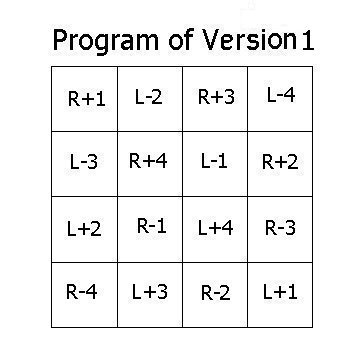
CHAN Mui Lai, Nebulae: Two Versions, 1998 The designer's sixteen-square format capacitates a family (i.e., a finite group) of 16 spirals, which all differ from one another combinatorially. The differentiations are manifested through the disposition of three divergent properties: an alternative of right versus left, an alternative of plus versus minus, and four discrete orientations: That is, eight spiral motifs are right-handed and eight are left-handed; eight are positive and eight are negative; four are oriented northward, four eastward, four southward, and four westward. Each of the 16 squares is subdivided into a 15 by 15 modular grid, upon which the spirals' four congruent, space-filling, interlocking arms are laid out. The arms of half of the spirals are one module wide at their origins; moving outward, each segment of the arms becomes one module wider, until a fifth segment of five modules is reached. The arms of the other half of the spirals are, in reverse, five modules wide at their origins; and moving outward, each segment becomes one module narrower, until the fifth segment is one module wide. The right-left property pertains to whether the arms, extending out from the spirals' origins, crook in a clockwise (R) or a counterclockwise (L) direction. The plus-minus property pertains to whether the arms, relative to the spirals' origins, expand (+) or contract (-). One arm of each spiral, assigned a special color (e.g., red), designates the (1, 2, 3, 4) orientation. Version 1-The three characterizing properties, which make possible the combinatorial group of 16 unique spirals, are distributed among the members of the group by three different methods-each method being appropriate to the nature of the specific characteristic. All 16 plus-minus dual opposites are checkerboarded across the full format of the design. Eight right-left dual opposites are checkerboarded over one half of the format, after which that half block of right-left checkers is mirrored (by a horizontal mirror axis-see "Program of Version 1") onto the other half of the format. All four orienatations are presented in each quadrant-though not in cyclic sequences-and are, furthermore, arranged as a Latin square within the full format: i.e. no number is repeated in any vertical or horizontal row. In deference to the orientations that, occurring at 90° intervals of rotation, are attendant in each spiral family (e.g., R+ family, L- family; see "schedule of elements"), all dissymmetric pairs of odd numbered members (e.g., R+1 and L+1) are mirrror-counterparts with regard-as can be discerned from examining the "Schedule of Elements"-to their respective vertical alignments; all pairs of even numbered members (e.g., R-4 and L-4) are mirror-counterparts with regard to their respective horizontal alignments. 
Numbers are not sequential around quadrat centers and |
